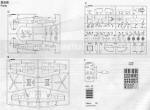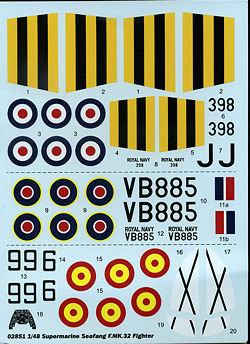
| KIT #: | 02851 |
| PRICE: | $31.99 SRP |
| DECALS: | Three options |
| REVIEWER: | Scott Van Aken |
| NOTES: |

| HISTORY |
The Seafang was essentially a Spiteful redesigned for Royal Navy carrier use, with the addition of an arrester hook, a contra-rotating propeller to eliminate engine torque effects, and power folding outer wing panels.
Two prototype Type 396 Seafang Mark 32s were ordered on 12 March 1945 followed by an order for 150 Type 382 Seafang Mark 31s on 7 May 1945. To expedite entry into service the interim Mark 31 was ordered which was a navalised Spiteful, basically a Spiteful with an arrestor hook. This would allow the Mark 32 to be developed, it would be the definitive naval variant, again with an arrestor hook but also folding outer wing panels and a contra-rotating propeller.
The first Seafang flew in 1946; it was the first interim production Mark 31 VG471. Although 150 of the interim variant were ordered, only nine were completed before the order was cancelled as the urgency of an interim type was removed due to the end of the war.
The first prototype definitive Mark 32 VB895 was first flown in June 1946. It was powered by a Griffon 89 engine rated at 2,350 hp (1,752 kW) driving two three-bladed contra-rotating propellers. In August 1946, VB895 was demonstrated to the Royal Netherlands Navy at Valkenburg. The same aircraft was flown by noted test pilot Mike Lithgow in May 1947, during deck landing trials on HMS Illustrious. Compared to the Seafire F.47, its performance advantage was not deemed to be enough to disrupt series production of new navalised Meteor and Vampire jet fighters. Also, the Seafang's low-speed handling characteristics were not as good as hoped, and the contemporary Hawker Sea Fury was preferred as a fleet fighter.
Seafang Mark 31 VG474 was used as a development aircraft for the Supermarine Attacker including the fitment of power-operated ailerons and contra-rotating propellers. The Attacker was a jet-powered development of the Spiteful/Seafang design which used the Spiteful laminar-flow wing and landing gear.
Drawing-board designIn 1943, as the design of the Spiteful was developing, Supermarine presented a brochure to the Air Ministry describing a "High-Performance Aeroplane for the Royal Navy", also known as the Supermarine 391. This design was intended to be used as a carrier-borne fighter, with a secondary role as a strike aircraft, able to carry an 18 inch (45.7 cm) Mark XV aerial torpedo. Bombs or rockets could also be carried and the fixed armament was four 20mm Hispano Vs. The 391 used the Spiteful/Seafang wing and undercarriage mated to a wide centre-section incorporating leading edge air intakes feeding the coolant radiators for a 3,550 hp, 24 cylinder 46-H-24 (later known as the "Eagle"); this engine drove contra-rotating, four-bladed propellers. The fuselage was longer with a redesigned fin and rudder unit.
Specifications for the 391 include a wingspan of 43 ft 6 in (13.3 m), a fuselage length of 39 ft 9 in (12.1 m) and a wing area of 335 ft² (31.2 m²). Maximum weights were 15,750 lb (7,144 kg) as a fighter and 17,250 lb (7,825 kg) when armed with a torpedo. The maximum speed was projected to be 546 mph (879 k/mh) at 25,000 ft (7,620 m).
Variants| THE KIT |
 After
producing the Spiteful a few months back, it was not surprising to see the
Seafang F.32 arriving from Trumpeter. This is because they are basically the
same airframe with just a few differences. Those differences being the tail
hook, contra rotating prop and the option to fold the wings. Much of the rest of
the airframe is identical so there was not a ton of additional computer work
required to produce this one.
After
producing the Spiteful a few months back, it was not surprising to see the
Seafang F.32 arriving from Trumpeter. This is because they are basically the
same airframe with just a few differences. Those differences being the tail
hook, contra rotating prop and the option to fold the wings. Much of the rest of
the airframe is identical so there was not a ton of additional computer work
required to produce this one.
There really is not all that much to this one, at least, compared to an armor kit or some modern jet kits. As the plane never saw unit service, there are no bombs, rockets or other things under the wings to break up the smooth lines of the aircraft. The kit comes with a nice four piece cockpit with a decal that can be used in place of painting the raised instrument panel. There is also a nice camera to stick in the fuselage as these aircraft all had a secondary tactical recon mission. The prop has a nice gear set on the inside so that the props move opposite each other when turned. If you have ever built the Lindberg XFY-1, then it is the same engineering, only smaller.
Photoetch is included for the oil cooler and coolant
radiators. I did not show the fret as it is pretty basic. The wheel wells are
inserts for the lower wing and you can lower the flap section if you so wish. To
be able to show the wings folded, you need to cut off the outer wing sections.
These have rib inserts and a small hinge piece. The kit has a separate
windscreen and canopy to show off the interior. Also optional is the ability to
have the tail hook section raised or lowere d.
Those few photos I have seen of the Seafang show all the various controls in the
neutral position.
d.
Those few photos I have seen of the Seafang show all the various controls in the
neutral position.
The kit comes with three markings options. One is of
one of the prototype F.32s in Dark Sea Grey (I think it shoul d
be Extra Dark Sea Grey) over Sky. I am not sure that the serials were shaded in
yellow, but that is how the decals show them. The other two are pure 'whiffers'.
The box art plane is in Suez Stripes and again, Dark Sea Grey over Sky. The
third option is for a Spanish aircraft in Silver over Light Blue. Not sure what
sort of leap was made to assume the Spanish would have needed a carrier capable
fighter in the late 1940s/early 1950s, but there you have it. Decals are very
nicely done and include the Suez Stripes. I would paint the fuselage stripes as
there is no way straight lines will properly match up on a compound curved
surface. The full color markings and painting guide offer a number of different
paint brands. As a note, the instructions call for an Interior Green for this
plane and that was probably what the prototypes used. Following standard FAA
coloring for the alleged operational time, this would have been black from the
side consoles on up.
d
be Extra Dark Sea Grey) over Sky. I am not sure that the serials were shaded in
yellow, but that is how the decals show them. The other two are pure 'whiffers'.
The box art plane is in Suez Stripes and again, Dark Sea Grey over Sky. The
third option is for a Spanish aircraft in Silver over Light Blue. Not sure what
sort of leap was made to assume the Spanish would have needed a carrier capable
fighter in the late 1940s/early 1950s, but there you have it. Decals are very
nicely done and include the Suez Stripes. I would paint the fuselage stripes as
there is no way straight lines will properly match up on a compound curved
surface. The full color markings and painting guide offer a number of different
paint brands. As a note, the instructions call for an Interior Green for this
plane and that was probably what the prototypes used. Following standard FAA
coloring for the alleged operational time, this would have been black from the
side consoles on up.
| CONCLUSIONS |
It is most welcome to see this aircraft in 1/48 scale and anyone modeling the Spitfire and variants in this scale will certainly want one to add to the collection. I would not be surprised to see the F.31 being kitted as well in the near future.
| REFERENCES |
http://en.wikipedia.org/wiki/Supermarine_Seafang
November 2012
Thanks to Squadron Products for the preview kit. You can get yours at your local hobby shop or on-line retailer.
If you would like your product reviewed fairly and fairly quickly, please contact the editor or see other details in the Note to Contributors.